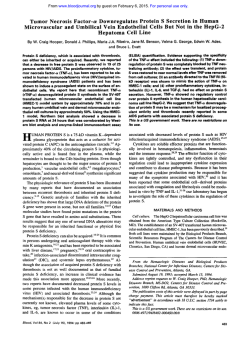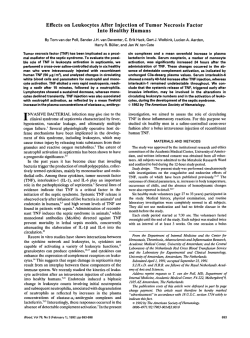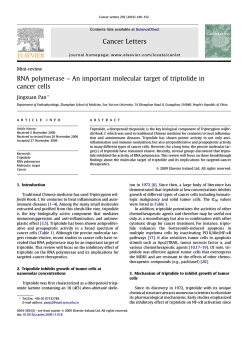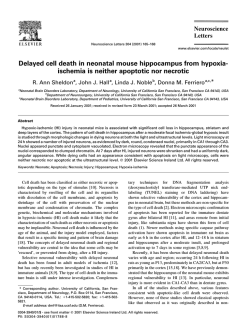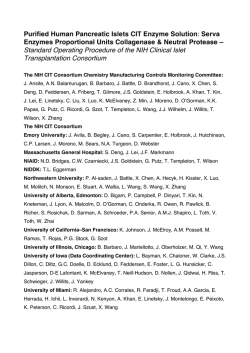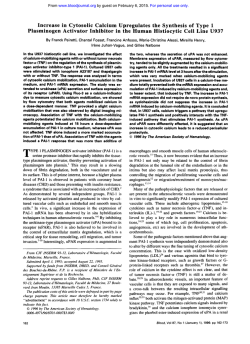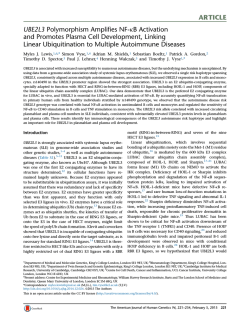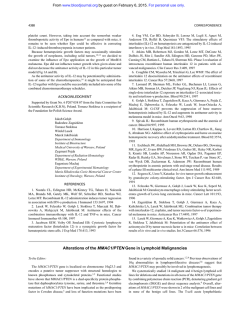
Protease Inhibitors Differentially Regulate Tumor Necrosis
From www.bloodjournal.org by guest on February 6, 2015. For personal use only. Protease Inhibitors Differentially Regulate Tumor Necrosis Factor-Induced Apoptosis, Nuclear Factor-NB Activation, Cytotoxicity, and Differentiation By Masahiro Higuchi, Sanjaya Singh, Henry Chan, and Bharat B. Aggarwal We investigatedthe effect of various proteaseinhibitors on TPCK-sensitive proteases are not involved in the early stages several tumor necrosisfactor (TNF)-mediated cellularreof signal transduction. TNF is cytotoxic and induces differensponses. Treatment of a human myelogenous leukemia cell tiation in ML-la cells after a 3-day incubation.TPCK had no line, ML-la, withTNF in the presence of cycloheximidetrigeffect on the TNF-induced cytotoxicity and differentiation, gers endonucleolytic activity and apoptotic celldeath within indicatingthat TPCK-sensitive proteases are specific for DNA 90 minutes. The general serine protease inhibitor diisopropyl fragmentation. TPCKalso blocked TNF-induced activation fluorophosphate (DFP) and the chymotrypsin-like protease of nuclear factor (NFI-KB. The dose-response andthe timeinhibitorN-tosyl-L-lysylchloromethyl ketone (TPCK)comcourse of the inhibitor, however, indicated that the site of pletely abrogated TNF-induced DNA fragmentation and the action ofTPCK for NF-KB activationand for DNA fragmentaformation of apoptotic bodies. However, 13 other protease tion are quite distinct. Therefore,we conclude that TNF actiinhibitors, including serine protease inhibitors, did not. The to vates two distinct TPCK-sensitive pathways, one leading addition ofTPCK to cells 30 minutes after TNF treatment apoptosis and the other to NF-KB activation. completely inhibited the cytokineaction,indicating that 0 1995 by The American Society of Hematology. T UMOR NECROSIS FACTOR (TNF) was first characterized from the sera of rodents infected with Bacillus Culmette-Guerin and subsequently treated with endotoxin; it was thencharacterized as a monokine that induces necrosis of certain tumors in vivo.’ Since then, a wide variety of biologic activities in vitro have been ascribed to TNF, including antiproliferative activity against tumor cells, stimulation of human fibroblasts, B-cell and thymocyte proliferation, induction of differentiation, antiviral effects, and induction of various gene expression.’ TNF now is known to beone of the most important mediators of cytotoxicity, inflammation, autoimmune diseases, and bone resorption in vivo.’ TNF interacts with a wide variety of cell types that express specific cell-surface receptors. The cDNA for two types of TNF receptor with approximate molecular masses of 60 kD and 80 k D , respectively, have been isolated.”6 Several reports showed that the signal through the p60 receptor is necessary for most biologic functions of TNF including cytotoxicity, the growth stimulation of fibroblast cells, induction of Mn-superoxide dismutase, antiviral activity, and endotoxin shock in However, p80 receptor is also known to mediate cytotoxicity, proliferation of murine thymocytes and humanmononuclear cells, and induction of granulocytemacrophage colony-stimulating factor (GM-CSF) secretion.10.’3-ih From the Cytokine Research Laboratory, Department of Molecular Oncology, The University of Texas M.D. Anderson Cancer Center, Houston, m. Submitted February 7, 1995; accepted May 10, 1995. This research was conducted in part by The Clayton Foundation for Research and was supported in part by new program development funds from the University of Texas M.D. Anderson Cancer Center. Address reprint requests to Bharat B. Agganual, PhD, Cytokine Research Laboratory. Department of Molecular Oncology, BOX41, The University ofTexas M.D. Anderson Cancer Center, Houston, TX 77030. The publication costs of this article were defrayed in part by page charge payment. This article must therefore be hereby marked “advertisement” in accordance with 18 U.S.C. section 1734 solely to indicate this fact. 0 1995 by The American Society of Hematology. 0006-4971/95/8606-0012$3.00/0 2248 We have shown that a myelogenous leukemia cell line, ML-la, exhibits cytotoxicity and differentiation in the presence of 10% fetal calf serum (FCS) after a 3-day incubation with TNF and apoptotic cell death within 4 hoursinthe absence of FCS.17Although signal mediated through the p60 receptor is sufficient to induce apoptosis, signals mediated through both receptors are needed to induce differentiation.I7 The postreceptor signals needed for TNF-mediated apoptosis, cytotoxicity, and differentiation, however, have not yet been identified. A number of hypotheses have been postulated to explain the mechanisms by which TNF cytotoxicity occurs. Signaling intermediates including oxygen radicals,’”-’’ phospholipase A2 (PLA2) activation,”~’5 sphingomyelinase activation,”and adenosine diphosphate (ADP) r i b o ~ y l a t i o n ~ ~ ~ ’ ~ have been implicated in the TNF action. As protease inhibitors suppress TNF-mediated cytotoxicity, a role for proteases has also been As de novo protein synthesis is not needed for TNF cytotoxicity,” protease activation rather than new synthesis may be required. We recently developed a bioassay system in which human TNF induces apoptotic cell death in ML- 1 a cells in the presence of cycloheximide within 90 minute~.~’ In the present study, we used this system to investigate the mechanism of TNF-induced apoptosis in ML-la cells. We report a specific protease inhibitor-sensitive pathway leading to apoptosis by TNF that is distinct fromthat of the pathwayleadingto nuclear factor (NF)-KB activation. MATERIALS AND METHODS Materials. Gentamicin, RPMI-1640 medium, and FCS were obNY). DiisopropylfluorophostainedfromGIBCO(GrandIsland, phate (DFP), phenylmethanesulfonyl fluoride (PMSF). aprotinin, Ntosyl-L-phenylalanyl chloromethyl ketone (TPCK), N-tosyl-L-lysyl Echloromethyl ketone (TLCK), benzamidine, leupeptin, antipain, 64, acetyl-leu-Leu nonnethional, pepstatin, phosphoramidon, captopril, N-tosyl-L-arginine methyl ester (TAME), dimethyl sulfoxide, NaCI, RNase K, proteinase K, bromphenolblue,xylenecyano], glycerol, okadaic acid, H-7, and nitroblue tetrazolium were obtained MO). The Bowman-Birk inhibifrom Sigma Chemical CO (St Louis, from Dr Ann Kennedy of the University of tor (BBI) was a gift Pennsylvania (Philadelphia, PA). Bacteria-derived recombinant human TNF, purified to homogeneity with a specific activity of 5 X IO’ Ulmg,wasprovided by Genentech Inc (SouthSan Francisco. CA). Blood, Vol 86,No 6 (September 15). 1995: pp 2248-2256 From www.bloodjournal.org by guest on February 6, 2015. For personal use only. 2249 REGULATION OF TNF-INDUCED SIGNALTRANSDUCTION Cell line. Myelogenous leukemia ML-la cell line was obtained from Dr Ken Takeda (Showa University, Tokyo, Japan) and was grown in RPMI-1640 medium supplemented with 10% FCS and gentamicin (50 pg/mL) (essential medium). The cells were seeded at a density of 1 X l@/mL in T-25 flasks (Falcon 3013, Becton Dickinson Labware, Lincoln Park, NJ) containing 10 mL of essential medium and were grown at 37°C in an atmosphere of 95% air and 5% CO,. Cell cultures were split every 3 or 4 days. Cytotoxicityassay. The cytotoxicity of ML-la cells was estimated by the inhibition of I3H]TdR incorporation into ML-la cells. For this, cells (5 X 103/well)were incubated with TNF for 72 hours. During the last 6 hours, ['HITdR was added to each well (0.5 pCi per well). Then, the cell suspension was harvested with the aid of a Filtermate 196 (Packard Instrument CO Ltd, Meriden, CT). Radioactivity bound to the filter was measured by Matrix 9600 (Packard). Cytotoxic activity was calculated as follows: % cytotoxicin control sample)] ity = [ l - (t3H]TdR in test ~ample)/([~H]TdR X 100. All results were determined in triplicate and expressed as mean 2 standard error. The results from this method of examining cytotoxicity correlated with that obtained by 3-(4-5-dimethylthiozol2-yl) 2-5-diphenyl-tetrazolium bromide ( M m ) assay or trypan blue exclusion method. DNA fragmentation assay by ['HITdR release. DNA fragmentation induced by TNF was assayed by the modified method as described." Briefly, ML-la cells were prelabeled with [3H]TdR by incubating 2 X lo5 cells per milliliter in essential medium with 0.5 pCi/mI. t3H]TdR at 37°C for 16 hours. Then, the cells were washed three times and resuspended in RPMI-1640 medium and plated in 96-well plates (4 X lo4 per well; total volume, 200 pL) with or without the test samples. To potentiate the TNF response, 1 mg/mL of cycloheximide was in~luded.3~ After incubation for 90 minutes or the indicated time, they were lysed by the addition of 50 pL of detergent buffer (10 mmoVL Tris-HCI, pH 8.0, containing 5 mmoV L EDTA and 2.5% Triton X-100) and incubated an additional 15 minutes at 4°C. High-speed centrifugation was performed on an Eppendorf microcentrifuge at 12,OOOg for 1 minute. The radioactivity in the supernatant represents DNA release into cells due to DNA fragmentation. For the total count, the cells were lysed by the addition of 20 pL of 20% sodium dodecyl sulfate (SDS). The percent DNA release was calculated as follows: 76 DNA fragmentation = (cpm in test sample supernatantkotal cpm) X 100. Each assay was performed in triplicate, and results are shown as the mean t standard error. Analysis of DNA fragmentation by agarose gel. After treatment of ML-la cells (1 X 106/0.2mI.) with TNF, cells were centrifuged, washed with phosphate-buffered saline, and resuspended in 40 pL of the lysis buffer (10 mmol/L Tris-Cl, pH 8.0, 100 mmom NaCI, 25 mmolk EDTA, and 0.5% SDS) containing 20 pg of RNase A. After incubation at 50°C for 30 minutes, 1 pL of 20 mg/mL proteinase K was added to the reaction mixture, and incubation was continued for another 30 minutes. Next, 8 pL of 6X loading dye (0.025% bromophenol blue, 0.25% xylene cyano1 FF, and 30% glycerol in water) was added, and 40 pL of the sample was resolved on 1.2% agarose gel in TAE buffer (0.04 molk Tris-acetate, 0.001 molk EDTA). Differentiation assay. Differentiation-inducing activity was assayed colorimetrically by the modified method of Baehner and Nathan.34Briefly, 4 X lo4 cells were plated in 96-well plates in the presence of test samples at a final volume of 200 pL and incubated for 3 days. Then, 20 pL of PBS containing 1.1 mg/mL of nitroblue tetrazolium and 1.1 pmolk phorbol myristate acetate (PMA) was added, and the solution was incubated for another 2 hours. The reaction was then terminated by adding 50 pL 2 N HCI and cooling on ice for 30 minutes. The medium was discarded, the formazan deposits were dissolved by adding 0.1 mL dimethyl sulfoxide, and the dissolved formazan was measured at 590 nm by a spectrophotometer. The final results were calculated and expressed as absorbance at 590 nm/106 cells. Each assay was performed in triplicate, and results are shown as the mean ? standard error. NF-KB induction assays. ML-la cells (2 X 106/0.1 mL) were treated with or without 0.1 nmolk TNF in the presence or absence of the indicated amount of TPCK for the indicated time at 37°C. Nuclear extracts were prepared according to Schreiber et al.35Briefly, 2 X lo6 cells were washed with cold PBS and suspended in 0.4 mL of lysis buffer (10 mmolk HEPES pH 7.9, 10 mmolk KCl, 0.1 mmolk EDTA, 0.1 mmoVL EGTA, 1 mmolk dithiothreitol [Dm], 0.5 mmom PMSF, 2.0 p g h L leupeptin, 2.0 p@mL aprotinin, and 0.5 mg/mL benzamidine). The cells were allowed to swell on ice for 15 minutes; after which time, 25 pL of 10% NP-40 was added. The tube was then vigorously vortexed for 10 seconds. The homogenate was centrifuged for 30 seconds in a microfuge. The nuclear pellet was resuspended in 25 pL ice-cold nuclear extraction buffer (20 mmolk HEPES pH 7.9, 0.4 mmoVL NaC1, 1 mmolk EDTA, 1 mmolk EGTA, 1 mmoVL DTT, 1 mmolk PMSF, 2.0 p@mL leupeptin, 2.0 pg/mL aprotinin, and 0.5 mg/mL benzamidine), and the tube was incubated on ice for 15 minutes with intermittent mixing. This nuclear extract was then centrifuged for 5 minutes in a microfuge at 4°C. and the supernatant was frozen at -70°C. The protein content was measured by the method of Bradford.36 Electrophoretic mobility shift assays were performed by incubating 4 to S pg of nuclear extract with 12 fmol of 32P-endlabeled, 45-mer double-stranded, NF-KB oligonucleotide from human immunodeficiency virus- 1 long terminal repeat (5"TTGTTACAAGGGACT'ITCCGCTGGGGACTlTCCAGGGAGGCGTGG-3')37in the presence of 0.5 pg of poly (dl-dC) in a binding buffer (25 mmolk HEPES pH 7.9, 0.5 mmoVL EDTA, 0.5 mmolk DTT, 1% NP-40, 5% glycerol, and 50 mmolk NaC1)3K.39 for 20 minutes at 37°C. The DNA-protein complex formed was separated from free oligonucleotide on a S% native polyacrylamide gel using buffer containing 50 mmom Tris, 200 mmolk glycine pH 8.5, and 1 rnmoVL EDTA."9 The gel was fixed in 10% acetic acid and dried. Quantitation and visualization of radioactive bands were performed using a phosphorimager (Molecular Dynamics, Sunnyvale, CA) with Imagequant software. RESULTS Effect of protease inhibitors on TNF-induced apoptosis. A number of protease inhibitors were tested for their effects on TNF-induced DNA fragmentation. The concentration of inhibitors used was not toxic as estimated by trypan blue method but was known to inhibit the appropriate protease action. The dose of each inhibitor required to inhibit 50% DNA fragmentation induced by 1 nmoVL TNF is shown in Table 1. The serine protease inhibitor DFP and chymotrypsin inhibitor TPCK showed a potent ability to prevent TNFinduced DNA fragmentation. TPCK was approximately lo4 times more potent in inhibiting TNF-induced DNA fragmentation than DFF' (Fig 1). However, other serine protease inhibitors such as PMSF, aprotinin, TLCK, BBI, and other inhibitors including leupeptin, antipain, E-64, acetyl-LeuLeu normethional, pepstatin, phosphoramidon, captopril, and TAME did not inhibit TNF-induced DNA fragmentation at the doses tested, indicating that chymotrypsin-like serine protease may be involved in TW-induced DNA fragmentation. We also determined the effect of TPCK on TNF-induced DNA fragmentation using agarose gel (Fig 2). The degradation of intact DNA and the formation of ladder was From www.bloodjournal.org by guest on February 6, 2015. For personal use only. HlGUCHl ET AL 2250 Table 1. The Effect of Protease Inhibitors onTNF-Induced Apoptosis Agent DFP PMSF TPCK BTEE APNE BB1 TLCK Leupeptin Antipain E-64 Acetyl-Leu-Leu normethional Pepstatin Phosphoramidon Captopril TAME ID- Specificity 4.5 mmol/L >5 mmol/L Serine protease Serine protease Chymotrypsin chymotrypsin Chymotrypsin Trypsin-chymotrypsin Trypsin Trypsin, cysteine protease Trypsin, cysteine protease Cysteine protease 0.22 pmol/L 35 pmol/L 38 pmol/L >l00 pg/mL >300 pmol/L >ZOO pmol/L >l00 pmol/L >l00 pmol/L Calpain II >l00 pmol/L Some aspartic protease Metalloprotease Angiotensin converting enzyme Nonspecific > l 0 0 pmol/L >l00 pmol/L >2 mmol/L >5 mmol/L l3H1TdR-prelabeled ML-la cells (4 x 10') were incubated with 1 nmol/L TNF and 1 pg/mL cycloheximide in the presence or absence of the indicated amounts of protease inhibitors for 90 minutes and then were tested for DNA fragmentation as described in Materials and Methods. The amounts of protease inhibitors that showed a 50% inhibition of DNA fragmentation are shown. Abbreviations: BTEE, N-benzoyl-L-tyrosine ethyl ester;APNE, Nacetyl-DL-phenylalanine o-naphthvl ester. Concentration (uM) Fig 1. Inhibition ofTNF-induced DNA fragmentation byserine protease inhibitors. 13H1TdR-prelabeledML-la cells (4 x 10'1 were incubated with 1 nmol/LTNF and 1pg/mL cycloheximide in the presence or absence of the indicated amountsof TPCK or DFP for 90 minutes and were tested for DNA fragmentation as described in Materials and Methods. The TPCK- and DFP-induced inhibitory levels were normalized to theamount of fragmented DNA in cells treated onlywith TNF and cycloheximide. Fig 2. Agarose gel electrophoresis of DNA fragments from TNFtreated cells. ML-la cells (2 x 10') were incubated in thepresence or absence of TNF (1 nmol/L) and cycloheximide (l pg/mL) with or without TPCK (10 pmol/L) for 90 minutes, and DNA from cells was processed for electrophoresis as described in Materials and Methods. observed in the cells treated with TNF and cycloheximide. and TPCK completely blocked this effect. We further investigated the effect of TPCK on the morphologic changes of ML-la cells after TNF treatment. A 90-minute TNF treatment in the presence of cycloheximide induced theformation of apoptotic bodies (Fig 3). and this change was abrogated by the addition of TPCK, indicating thatTPCKblocked TNF-induced apoptotic body formation. There was no detectable formation of apoptotic bodies in the control cells or in the TPCK-treated cells. DFP also completely abrogated the apoptotic body formation in ML-la cells induced by TNF (data not shown). These results clearly demonstrate that TPCK blocked TNF-induced apoptosis in ML- I a cells. Kinetics o f inhihitiorl of TNF-induced DNA,frcr~lnentfition /?yTPCK. To determine where the TPCK-sensitive element resides in the pathway leading to apoptosis induced by TNF, TPCK was added at the same time as or 30 or 60 minutes after TNF addition, andinhibition ofDNA fragmentation was measured (Fig 4). The addition of TPCK at time 0 and 30 minutes completely blocked the TNF effect. When TPCK waspresentonly in the last 30 minutes of the 90-minute reaction time. DNA fragmentation was significantly but partially inhibited. indicating that this TPCK-sensitive component was activated from 30 to 90 minutes after TNF treatmen t . Efect o f TPCK on H-7- nnd okodoic acid-induced DNA .frapentntiorr. We also examinedwhetherTPCKinhibits apoptosis induced by inducers other than TNF. As protein kinase C inhibitor H-7 and serinekhreonine protein phosphatase inhibitor okadaic acid"'." have also beenreportedto induce apoptosis. we examined the effect of TPCK on apoptosis induced by these agents. ML-la cells were incubated with H-7 or okadaic acid for 4 hours, and the effect of TPCK was examined. As shown in Fig S , TPCK nearly completely inhibited H-7- and okadaic acid-induced DNA fragmentation. thus suggesting that TPCK is a more general inhibitor of apoptosis. Efect of TPCK on TNF-induced cytoto.ricify nnd diferentintion. TPCK may interfere withanearlyandgeneral event of TNF signals that is linked to varieties of biologic functions, or it may block just the apoptosis-specific signals. To examine this, we measured the effects of TPCK on two different biologic functions: cytotoxicity and differentiation in ML-la cells. Treatment with 1 pglmL ofTPCK com- From www.bloodjournal.org by guest on February 6, 2015. For personal use only. REGULATION OF TNF-INDUCED SIGNAL TRANSDUCTION 2251 +TPCK ? +TNF I l Fig 3. The effect of TPCK onthemorphologic changes induced by TNF in ML-la cells. Cells were incubated in the absence or presence of TNF (1nmoll L) and cycloheximide (1 pg/mL) with and without TPCK ( l 0 p m o l / L I for 90 minutes, and then micrographs weretaken(originalmagnification x 2001. I TPCK treatment ' , 1 -' . T T 0 None 1 W +TPCK 0 10 100 loo0 TNF (PM) Fig 4. Effect of TPCK added atvarious times afterTNF treatment. ['HlTdR-prelabeled ML-la cells (4 x 10') were incubatedwith 1nmoll added LTNF and1p g l m L cycloheximide. TPCK (10 pmol/L) was then at 0, 30, and 60 minutes after TNF addition. At time 90 minutes, the reaction wasstopped, and fragmented DNA was determined as described in Materials and Methods. control H-7 okadaic acid Fig 5. Inhibition ofH-7- and okadaic acid-induced DNA fragmentation by TPCK. ['HlTdR-prelabeled ML-la cells (4 x 10') were incubated with either 500 pmol/L H-7 or 500 pmollL okadaic acid in the presence or absence of 10 pmol/L TPCK for 4 hours and then were tested forDNA fragmentation as described in Materials andMethods. From www.bloodjournal.org by guest on February 6, 2015. For personal use only. HlGUCHl ET AL 10' 102 lo3 Fig 6. The effect of TPCK on TNF-induced DNA fragmentation, cytotoxicity, and differentiation.(A) [3H]TdR-prelabeledML-la cells (4 x 10') were incubated with the indicated amount of TNF and 1 pglmL cycloheximide in the presence or absenceof 1 pmollL TPCK for 90 minutes and were tested for DNA fragmentation as described in Materials and Methods. (B) ML-la cells (5 x l@)were incubated with the indicated amount of TNF in the presence or absence of 1 pmollL TPCK for 3 days and were tested for their cytotoxic activity as described in Materials and Methods. (C) Cells (4 x 10') were incubated with the indicated amount of TNF and in the presence or absence of 1 pmollL TPCK for 3 days and were tested for their differentiation-inducing activityas described in Materials and Methods. pletely blocked TNF-induced DNA fragmentation (Fig 6A), but the same dose did not affect the cytotoxicity (Fig 6B) and differentiation-inducing effect (Fig 6C) of TNF. The results clearly indicate that the specific blockade of apoptosis-specific signaling of TNF is independent of cytotoxicity or differentiation. Due to the toxicity of the inhibitor alone, we could not use TPCK at concentration higher than 5 pmol/L. (data not shown). Effect of TPCK on the induction of NF-KB. Similar to apoptosis, another early action of TNF is activation of NFKB. The NF-KB activation by TNF in ML-la cells can be noted within 15 minutes, and its level remained unchanged until up to 90 minutes (Fig 7). Furthermore, cycloheximide had no effect on the TNF-dependent NF-KB activation. We also investigated whether TPCK inhibited TNF-induced NFKB activation. As shown in Fig 8A, TPCK abrogated rapid induction of NF-KB by TNF in ML-la cells. However the component for NF-KB activation was approximately 50 times more resistant to TPCK than that for the induction of DNA fragmentation (Fig 8B). DISCUSSION Our results presented here demonstrate that a TPCK- and DFP-sensitive element is involved in the signal transduction sequence of TNF-induced apoptosis. This element is specific to apoptosis but was not involved in TNF-induced cytotoxic- ity and differentiation. We also found a TPCK-sensitive element in the NF-KB activation pathway, but this element was completely distinct from that in the pathway leading to apoptosis: the former appears much earlier (less than 15 minutes) and requires a 50-times higher dose of TPCK. We have previously shown that the trypsin-type protease inhibitor TLCK can inhibit the cytotoxic action of mouse TNF in L.P3 cells, a clone of a mouse fibroblast cell line L929.29Others have also reported that serine protease inhibitors abrogated the effect of human TNF on L-929 ~ e l l s . ~ ' , ~ ' These experiments used human TNF on murine target cells. Both p60 and p80 forms of TNF receptors are capable of transducing the ~ignal.'~."~'' Because human TNF binds only the murine p60 TNF receptor, human target cells that interact with both receptors are preferable. Most of the human TNF assay systems currently available to study signaling require a 2- to 3-day incubation period, which is undesirable because, during this time, inhibitors themselves maybetoxictothe cells. To investigate the mechanisms of action of human TNF, we developed a system to detect TNF-induced DNA fragmentation in ML-la, which requires 90 minutes of incubation time. We demonstrated that the protease inhibitors TPCK and DFP blocked TNFinduced apoptosis. TPCK is an alkylating agent, reacting specifically and irreversibly with the histidine residue in the active center of proteases, and has a high affinity for chymo- From www.bloodjournal.org by guest on February 6, 2015. For personal use only. 2253 REGULATION OF TNF-INDUCEDSIGNALTRANSDUCTION 0 1 5 60 30 90 time ( m i d NF-KB B Fig 7. Kinetics of NF-KB activation by TNF. ML-la cells (2 x 10') were incubated with 1 nmol/L TNF in the presence or absence of 1 p g l m L cycloheximide (CHXI for the indicated times, and NF-KB activation was estimatedas described in Materials and Methods. 100 r NF-kB activation 80 trypsin andchymotrypsin-like enzymes."' DFP is anirreversible serine protease inhibitor reacting with serine residues in its active center. Both are hydrophobic low-molecularweight molecules and are expected to penetrate the cell membrane and act intracellularly. In contrast, serine protease inhibitors aprotinin and BBI, which do not penetrate the cells and are thus supposed to act extracellularly, did not affect TNF action. Therefore, TNF may activate an intracellular chymotrypsin-like serine protease or induce the sensitivity of the substrate to the TPCK-sensitive protease. Although TPCK is also known to inhibit protein synthesis: the effect of TPCK onTNF action is notlikely to be due to thesuppression of protein synthesis, because we used protein synthesis inhibitor cycloheximide in our assay system. Interestingly, in our studies, the protease inhibitors (PMSF and TLCK) that are known to block TNF-mediated cytotoxicity,'"-3' had no effect on TNF-mediated apoptosis in ML-la cells; thus, again suggesting that the pathway leading to apoptosis is distinct from that of cytotoxicity. This TPCK-sensitive elementisnot specific to TNF-induced apoptosis, as TPCK also inhibited the apoptosis induced by H-7 and by okadaic acid. The molecular mechanisms associated with the apoptotic process are not entirely clear. TNF has beenreportedto induce apoptosis characterized by membrane blebbing, chromatin margination, and the breakdown of chromosomal DNA into nucleosome-sized fragments in some tumor cells.*~JsIn our previous studies, we also noted apoptotic 60 40 20 (I l 10" loo 10' TPCK (uM) Fig 8. Inhibition of TNF-induced NF-KB activation by TPCK. (AI ML-la cells (2 x 10') were incubated with or without1 nmoi/L TNF in the presence of the indicated amount of TPCK for 90 minutes, and NF-KB induction was estimated as described in Materials and Methods. (B) The effect of TPCK on NF-KB activation wascompared with DNA fragmentation, both induced by TNF. The TPCK-induced inhibitory levels were normalized t o the fragmented DNA and the amount of activated NF-KB in cells treated only with TNF. From www.bloodjournal.org by guest on February 6, 2015. For personal use only. 2254 body formation, nucleosome-sized fragments of DNA on agarose gels, and DNA fragmentation resulting in thymidine release under identical conditions after TNF treatment of ML-la cells.’7 Whether TNF induces apoptosis by the same mechanisms as in other systems has notbeen answered. However, some characteristics of TNF-induced apoptosis in ML-la cells are different from T-cell apoptosis induced by agents such as anti-CD3 antibodies. Apoptosis in T cells requires new protein synthesis,* but the TNF-induced process is not inhibited by a protein synthesis inhibitors,32suggesting that these cells already have the molecules required for this process. T-cell receptor-triggered programmed cell death was inhibited by the cysteine protease inhibitor E-64 and leupeptin, the calpain-selective inhibitor acetyl-Leu-Leu normethional, and the serine protease inhibitors DFP and PMSF.47Like TNF, topoisomerase I is another inducer of apoptosis that does not require new protein s y n t h e ~ i sthis ;~~ apoptosis, however, is blocked notonly by TPCK but also by other serine protease inhibitors including TLCK and TAME. From the difference of spectrum of protease inhibitors, we conclude that distinct proteases are involved in apoptosis of T cells, in topoisomerase I-induced apoptosis, and in TNFinduced apoptosis. Two genes, ced-3 and ced-4, are essential for cells to undergo programmed cell death in C e l e g ~ n sThe . ~ ~amino acid sequence of CED-3 protein is similar to the mammalian interleukin (1L)-l@-converting enzyme.50This protein is a cysteine protease, and overexpression of this gene causes the cells to undergo a p o p t o ~ i sHowever, .~~ the proteases activated by TNF are clearly different from the IL-l@-converting enzyme because of the differences in the spectrum of action of protease inhibitors. The role of ADP ribosylation in TNF-mediated cytotoxicity has been dem~nstrated.~’.~’ It was also proposed that the proteolytic cleavage of the poly (ADP-ribose) polymerase, a 116-kD protein, may be involved in apoptosis, because cleavage to 85- and 25-kD fragments and apoptosis induced by etoposide were shown to be sim~ltaneous.~’ At present. we do not know whether proteases involved in this proteolytic cleavage and those in TNF-induced apoptosis are the same. Collectively, several distinct proteases may have the potential to induce apoptosis. Are different mechanisms involved in TNF-mediated cytotoxicity in L.P3 cells and L-929 cells, apoptotic cell death in ML- la cells, and cytotoxicity in ML-la cells? Cytotoxic activity that can be observed 3 days after TNF treatment in ML- la cells may be mainly the results of the cytostatic action of TNF. Mitochondrial dysfunction can decrease intracellular adenosine triphosphate (ATP) levels, and this may lead to cytostasis but not ~ y t o l y s i sSince . ~ ~ TNF has been shown to induce damage in the mitochondrial respiratory chain in TNF-sensitive cell^,'^^^^ this mechanism may also be responsible for cytotoxicity in ML-la cells. TNF-induced cytotoxicity in ML- 1a cells was not inhibited by TPCK, suggesting that TPCK-sensitive protease is not involved in the dysfunction of mitochondrial respiratory chain. In L.P3 and L-929 cells, TNF induces cytolysis (membrane disruption) without DNA fragmentati~n.~~ We and others have demonstrated that the TNF-mediated damage to the mitochondrial respiratory HlGUCHl ET AL chain precedes the PLA2 activation, leading to lysis of L.P3 and L-929 Serine proteases that act in L.P3 and L-929 cells after TNF treatment may transmit the signals from mitochondria disfunction, leading to PLA2 activation. Apoptotic cell death was rapidly induced after TNF and cycloheximide treatment without membrane disruption.” Whether mitochondrial damage is essential to induce apoptosis, however, needs to be examined. At the least, distinct mechanisms may be involved in these three cytotoxic mechanisms induced by TNF. TNF regulates the transcription of several genes, and some of them are regulated by the transcriptional factor N F - K B . ~ ~ The activation of NF-KB involves the dissociation of the heterodimeric components p65 and p50 from the inhibitory subunit IKB, followed by its translocation to the nucleus.55 Rapid degradation of IkB was found to be a key event for this mechanism.56Machleidt et a157reported that serine protease inhibitors blocked the degradation of I k B and, thus, inhibited NF-KB activation. Our results show that in the signal transduction of TNF, the TPCK-sensitive component involved in apoptosis and that involved in NF-KB activation were quite different for the following reasons. (1) The TPCK-sensitive component for apoptosis appeared later. (2) The element for NF-KBactivation was approximately 50 times more resistent to TPCK than that for DNA fragmentation. Although these two pathways are distinct, we could not estimate whether they are linked in some manner. Because of the difference in conditions required, we could not examine whether the TPCK ( l 0 pmoVL)-sensitivepathway involved in NF-KB activation (30 minutes) is also involved in cytotoxicity and differentiation (72 hours). Future studies on the characterization of the TPCK-sensitive proteases may provide further insight into the mechanisms of TNF action. ACKNOWLEDGMENT We are verythankful to DrBryant G. Darnay,DrShrikanth Reddy, and Walter Pagel for their thoughtful reviews of the manuscript and helpful suggestions. REFERENCES I , Carswell EA, Old LJ, Kassel RL, Green S, Fiore N, Williamson B: An endotoxin-induced serumfactorthat causes necrosis of tumors. Proc Natl Acad Sci USA 72:3666, 1975 2. Aggarwal BB, Vilcek J (eds): Tumor Necrosis Factor: Structure, Function, and Mechanism of Action. New York, NY, Marcel Dekker, 1992, p 1 3. Loetscher H, Pan Y-CE, Lahm H-W, Gentz R, Brockhaus M, Tabuchi H, Lesslauer W: Molecular cloning and expression of the human 55 kd tumor necrosis factor receptor. Cell 61:351, 1990 4. Schall TJ, Lewis M, Koller KJ, Lee A, Rice G C , Wong GHW, Gatanaga T, Granger GA, Lentz, R, Raab H, Kohr WJ, Goeddel DV: Molecular cloning and expression of areceptorforhuman tumor necrosis factor. Cell 61:361, 1990 5. Smith CA,Davis T, Anderson D, Solam L, Beckman MP, Jerzy R, Dower SK, Cosman D, Goodwin RG: A receptor for tumor necrosis factor defines an unusual family of cellular and viral proteins. Science 248:1019, 1990 6 . Kohno T, Brewer MT, Baker SL, Schwaltz PE, King MW, Hale KK, Squires CH, Thompson RC, Vannice JL: Second tumor necrosis factor receptor gene product can shed a naturally occumng From www.bloodjournal.org by guest on February 6, 2015. For personal use only. REGULATION OF TNF-INDUCEDSIGNALTRANSDUCTION tumor necrosis factor inhibitor. Proc Natl Acad Sci USA 87:8331, 1990 7. Espevik T, Brockhaus M, Loetscher H, Nostad U, Shalaby R. Characterization of binding and biological effects of monoclonal antibodies against a human tumor necrosis factor receptor. J Exp Med 171:415, 1990 8. Englemann H, Holtman H, Brakebusch C, Avin, YS, Sarov I, Nophar Y, Hadas E, Leitner 0, Wallach D: Antibodies to a soluble form of a tumor necrosis factor (TNF) receptor have TNF-like activity. J Biol Chem 265:14497, 1990 9. Thoma B, Grell M, Plizenmaier K, Scheurich P: Identification of 60-kD tumor necrosis factor (TNF) receptor as the major signal transducing component in TNF responses. J Exp Med 172:1019, 1990 IO. Tartaglia LA, Weber RF, Figari IS, Reynold C, Palladino MA Jr, Goeddel DV: The two different receptors for tumor necrosis factor mediate distinct cellular responses. Proc Natl Acad Sci USA 88:9292, 1991 11. Wong GHW, Tartaglia LA, Lee MS, Goeddel DV: Antiviral activity of tumor necrosis factor (TNF) is signaled through the 55kDa receptor, type I TNF. J Immunol 149:3350, 1992 12. Pfeffer K, Matsuyama T, Kundig TM, Wakeham A, Kishihara K, Shahinian A, Wiegmann K, Ohashi PS, Kronke M, Mak TW: Mice deficient for the 55 kd tumor necrosis factor receptor are resistent to endotoxin shock, yet succumb to L. monocytogenes infection. Cell 73:457, 1993 13. Grell M, Scheurich P, Meager A, Pfizenmaier K: TR60 and TR80 tumor necrosis factor (TNF)-receptors can independently mediate cytolysis. Lymphokine Cytokine Res 12:143, 1993 14. Heller RA, Song K, Fan N, Chang DJ: The p70 tumor necrosis factor receptor mediates cytotoxicity. Cell 70:47, 1992 15. Gehr G , Gentz R, Brockhaus M, Loetscher H, Lesslauer W: Both tumor necrosis factor receptor types mediate proliferative signals in human mononuclear cell activation. J Immunol 149:911, 1992 16. Vandenabeele P, Declercq W, Vercammen D, Van de Craen M, Grooten J, Loetscher H, Brockhaus M, Lesslauer W, Fiers W: Functional characterization of the human tumor necrosis factor receptor p75 in a transfected rat/mouse T cell hybridoma. J Exp Med 176:1015, 1992 17. Higuchi M, Aggarwal BB: Differential roles of two forms of TNF receptor on TNF-induced cytotoxicity, DNA fragmentation and differentiation. J Immunol 152:4017, 1994 18. Matthews N, Neale ML, Jackson SK, Stark JM: Tumor cell killing by tumor necrosis factor: Inhibition by anaerobic conditions, free-radical scavengers and inhibitors of arachidonate metabolism. Immunology 62:153, 1987 19. Higuchi M, Shirotani K, Higashi N. Toyoshima S, Osawa T: Damage to mitochondrial respiration chain is related to phospholipase AZ activation caused by tumor necrosis factor. J Immunother 2:41, 1992 20. Schulze-Osthof K, Bakker AC, Vanhaesebroeck B, Beyaert R, Jacob WA, Fiers W: Cytotoxic activity of tumor necrosis factor is mediated by early damage of mitochondrial functions. J Biol Chem 267:5317, 1992 21. Schulze-Osthoff K, Beyaert R, Vandevoorde V, Haegeman G , Fiers W: Depletion of mitochondrial electron transport abrogates the cytotoxic and gene-inductive effects of TNF. EMBO J 12:3095, 1993 22. Kobayashi Y, Sawada J, Osawa T Activation of membrane phospholipase A by guinea pig lymphotoxin (GLT). J Immunol 122:791, 1979 23. Neale ML, Fiera RA, Matthews D: Involvement ofphospholipase A2 activation in tumor cell killing by tumor necrosis factor. Immunology 64:81, 1988 2255 24. Oka S, Arita H Inflammatory factors stimulate expression of group I1 phospholipase Az in rat cultured astrocytes. Two distinct pathways of the gene expression. J Biol Chem 266:9956, 1991 25. Hayakawa M, Ishida N, Takeuchi K, Shibamoto S, Hori T, Oku N, It0 F, Tsujimoto M: Arachidonic acid-selective cytosolic phospholipase A2 is crucial in the cytotoxic action of tumor necrosis factor. J Biol Chem 268:11290, 1993 26. Kolesnick R, Golde DW: The sphingomyelin pathway in tumor necrosis factor and interleukin-l signaling. Cell 77:325, 1994 27. Aganval S, Drysdale B-E, Shin HS: Tumor necrosis factormediated cytotoxicity involves ADP-ribosylation. J Immunol 140:4187, 1988 28. Lichtenstein A, Gera JF, Andrew J, Berenson J, Ware CF: Inhibitors of ADP-ribose polymerase decrease the resistance of HERYneu-expressing cancer cells to the cytotoxic effects of tumor necrosis factor. J Immunol 146:2052, 1991 29. Takeda Y, Shimada S, Sugimoto M, Woo HJ, Higuchi M, Osawa T: Purification and characterization of a cytotoxic factor produced by a mouse macrophage hybridoma. Cell Immunol96:277, 1985 30. Ruggiero V, Johnson SE, Baglioni C: Protection from tumor necrosis factor cytotoxicity by protease inhibitors. Cell Immunol 107:317, 1987 31. Suffys P, Beyaert R, Van Roy F, Fiers W: Involvement of a serine protease in tumor-necrosis-factor-mediated cytotoxicity. Eur J Biochem 178:257, 1988 32. Kull FC, Cuatrecasas P: Possible requirement of internalizationin the mechanism ofin vitro cytotoxicity in tumor necrosis serum. Cancer Res 41:4885, 1981 33. Higuchi M, Singh S, Aggarwal BB: Characterization of apoptotic effects of human tumor necrosis factor: Development of highly rapid and specific bioassay for human tumor necrosis factor and lympbotoxin using human target cells. J Immunol Methods 178:173, 1994 34. Baehner RL, Nathan DG: Quantitative nitroblue tetrazolium test in chronic granulomatous disease. N Engl J Med 278:971, 1968 35. Schreiber E, Matthias P, Muller MM, Schaffner W: Rapid detection of octamer binding proteins with ‘mini-extracts’, prepared from a small number of cells. Nucleic Acids Res 175419, 1989 36. Bradford MM: A rapid and sensitive method for quantitation of microgram quantities of protein utilizing the principle of proteindye binding. Anal Biochem 72:248, 1976 37. Nabel G , Baltimore D: An inducible transcription factor activates expression of human immunodeficiencyvirus in T cells. Nature 326:7 1I, 1987 38. Collart MA, Baeuerle P, Vassalli P: Regulation of tumor necrosis factor alpha transcription in macrophages: Involvement of four KB-like motifs and of constitutive and inducible forms of NFKB. Mol Cell Biol 10:1498, 1990 39. Hassanain HH, Dai W, Gupta SL: Enhanced gel mobility shift assay for DNA-binding factors. Anal Biochem 213:162, 1993 40. Mcconkey DJ, Hartzell P, Amardor-Perez JF: Orrenius S, Jondal M: Calcium-dependent killing of immature thymocytes by stimulation via the CD3m cell receptor complex. J Immunol 143:1801, 1989 41. Boe R, Gjertsen BT, Vintermyr OK, Houge G , Lanotte M, Doskeland SO: The protein phosphatase inhibitor okadaic acid induces morphological changes typical of apoptosis in mammalian cells. Exp Cell Res 195237, 1991 42. Schoellmann G , Shaw E: Direct evidence for the presence of histidine in the active center of chymotrypsin. Biochemistry 2:252, 1962 43. Cbou I-N, Black PH, Rohlin RO: Non-selective inhibition of transformed cell growth by protease inhibitor. Proc Natl Acad Sci USA 71:1748, 1974 From www.bloodjournal.org by guest on February 6, 2015. For personal use only. 2256 4 4 . Laster SM, Wood JG, Gooding LR: Tumor necrosis factor can induce both apoptotic and necrotic forms of cell lysis. J Immunol 141:2629,1988 45. Wright SC, Kumar P, Tam AW, Shen N, Varma M, Larrick JW: Apoptosis and DNA fragmentation precede TNF-induced cytolysis in U937 cells. J Cell Biochem 48:344, 1992 46. Cohen JJ, Duke RC: Glucocorticoid activation of a calciumdependent endonuclease in thymocyte nuclei leads to cell death. J Immunol 132:38, 1984 47. Sarin A, Adams DH, Henkart PA: Protease inhibitors selectively block T cell receptor-triggered programmed cell death in a murine T cell hybridoma and activated peripheral T cells. J Exp Med 178:1693,1993 48. Bruno S, Bino GD, Lassota P, Giaretti W, Darzynkiewicz Z: Inhibitors of proteases prevent endonucleolysis accompanying apoptotic death of HL-60 leukemic cells andnormal thymocytes. Leukemia 6: 1 113, 1992 49. Ellis H, Horvitz HR: Genetic control of programmed cell death in the nematode C. elegans. Cell 44:817, 1986 50. Miura M, Zhu H, Rotello R, Hartwieg EA, Yuan J: Induction of apoptosis in fibroblasts by IL-l@-converting enzyme, a mamma- HlGUCHl ET AL lian homolog of the C. elegans cell death gene ced-3. Cell 75:653. 1993 51. Kaufmann SH, Desnoyers S, Ottaviano Y, DavidsonNE, Poirier GG: Specific proteolytic cleavage of poly(ADP4bose) polymerase: An earlymarker of chemotherapy-inducedapoptosis. Cancer Res 53:3976,1993 52. Hibbs JB Jr, Taintor RR, Vavrin Z: Macrophage cytotoxicity: Role for L-arginine deiminase and imino nitrogen oxidation to nitrite. Science 235:473, 1987 53. Liddil JD, Dorr RT. Scuderi P: Association of lysosomal activity with sensitivity and resistance to tumor necrosis factor in murine L929 cells. Cancer Res 49:2722, 1989 54. Leonard MJ, Baltimore D: NF-KB: A pleiotropic mediator of inducible and tissue-specific gene control. Cell 58:227, 1989 55. Baueurle PA, Baltimore D: I-KB: A specific inhibitor of the NF-KB transcription factor. Science 242540, I988 56. Henkel T, Machleidt T, Alkalay I, Kronke M, Ben-Neriah Y, Baeuerle PA: Rapid proteolysis of I-KB-cxis necessary for activation of transcription factor NF-KB. Nature 365:182, 1993 57. Machleidt T, WiegmannK, Henkel T, Schutze S, Baeuerle P. Kronke M: Sphingomyelinase activates proteolytic IKB-cxdegradation in a cell-free system. J Biol Chern 269:13760, 1994 From www.bloodjournal.org by guest on February 6, 2015. For personal use only. 1995 86: 2248-2256 Protease inhibitors differentially regulate tumor necrosis factorinduced apoptosis, nuclear factor-kappa B activation, cytotoxicity, and differentiation M Higuchi, S Singh, H Chan and BB Aggarwal Updated information and services can be found at: http://www.bloodjournal.org/content/86/6/2248.full.html Articles on similar topics can be found in the following Blood collections Information about reproducing this article in parts or in its entirety may be found online at: http://www.bloodjournal.org/site/misc/rights.xhtml#repub_requests Information about ordering reprints may be found online at: http://www.bloodjournal.org/site/misc/rights.xhtml#reprints Information about subscriptions and ASH membership may be found online at: http://www.bloodjournal.org/site/subscriptions/index.xhtml Blood (print ISSN 0006-4971, online ISSN 1528-0020), is published weekly by the American Society of Hematology, 2021 L St, NW, Suite 900, Washington DC 20036. Copyright 2011 by The American Society of Hematology; all rights reserved.
© Copyright 2025
